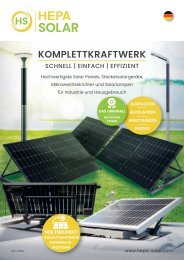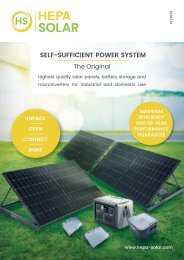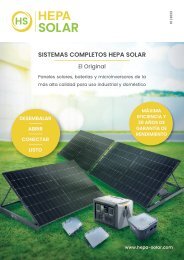Bedienungsanleitung Amalgamseparator CATTANI-D
- Keine Tags gefunden...
Erfolgreiche ePaper selbst erstellen
Machen Sie aus Ihren PDF Publikationen ein blätterbares Flipbook mit unserer einzigartigen Google optimierten e-Paper Software.
SEPARATORE<br />
PER AMALGAMA<br />
AMALGAM SEPARATOR<br />
SEPARATEUR D’AMALGAME<br />
AMALGAMSEPARATOR<br />
SEPARADOR POR AMALGAMA<br />
• MANUALE ISTRUZIONI<br />
• OPERATOR’S HANDBOOK<br />
• MANUEL D'INSTRUCTIONS<br />
• GEBRAUCHSANWEISUNGEN<br />
• MANUAL DE INSTRUCCIONES<br />
<strong>CATTANI</strong> S.p.A.
SEPARATORE PER AMALGAMA<br />
Montaggio ed uso<br />
Pericolo biologico, infezioni da malattie epidemiche.<br />
Direzione obbligatoria del flusso o del senso di rotazione.<br />
Gli ingressi i4 e i5 sono destinati rispettivamente a ricevere il drenaggio del vaso separatore (o canister) e lo<br />
scarico della sputacchiera.<br />
ll passaggio o4 deve essere collegato allo scarico dell'ambiente fig. 1. Le particelle leggere che galleggiano<br />
sul liquido in drenaggio non vengono trattenute, viceversa le particelle pesanti, e tra queste l'amalgama, si<br />
fermano sul fondo del separatore, fig. 1. L’aspirato è contaminante per le malattie epidemiche, perciò prima<br />
di ogni intervento su apparecchi usati, aspirare un disinfettante ed aspettare che agisca. Indossare: guanti,<br />
occhiali, mascherina e grembiule monouso per proteggersi da spruzzi.<br />
Per liberare dall'amalgama il separatore è necessario: inclinare il separatore in modo che la maggior parte del<br />
liquido dreni, fig. 2, operare con lentezza perchè non esca l’amalgama, togliere il coperchio art. 201060 girandolo<br />
nel senso indicato dalla freccia A fig. 3, appoggiare il recipiente a perdere per il trasporto dei rifiuti di amalgama<br />
art. 043010 tenendolo pressato sul separatore art. 201100 fig. 4, capovolgere rapidamente e scuotere in modo<br />
che i rifiuti di amalgama passino completamente dal separatore al recipiente a perdere fig. 5.<br />
Riempire il vasetto a perdere con un disinfettante.<br />
ll coperchio 201020 garantisce una buona chiusura, consigliamo comunque di assicurare il coperchio con un<br />
giro di nastro adesivo fig. 6, mantenere sempre il recipiente in posizione verticale e maneggiare con cura.<br />
Lo smaltimento dell’amalgama di ricupero (prodotto contaminante e tossico nocivo) deve essere fatto attraverso<br />
smaltitori autorizzati. L’elenco degli smaltitori autorizzati è esposto alle Camere di Commercio. Per ulteriori<br />
informazioni rivolgersi alle autorità locali ed alle associazioni sindacali di categoria.<br />
Il venditore autorizzato ed il fabbricante sono a disposizione per ulteriori informazioni, consigli e parti di ricambio.<br />
Le prove di manutenzione è bene siano fatte ad apparecchi nuovi prima dell’uso per evitare contaminazioni.<br />
Il presente apparecchio non ha omologazioni, viceversa i nostri modelli Idrocicloni ISO sono omologati secondo<br />
le normative UNI EN ISO 11143.<br />
i5<br />
o4<br />
i4<br />
Fig. 1
AMALGAM SEPARATOR<br />
Installation and use<br />
Biological danger, danger of infections from epidemic diseases.<br />
Compulsory direction of flow and rotation.<br />
Inlets i4 and i5 are to be connected to the canister draining pipe and to the spittoon draining pipe<br />
respectively. Outlet o4 must be connected to the waste line (figure 1).<br />
Light particles floating on the drained liquid cannot be trapped but heavier ones, among which<br />
amalgam waste, are drawn to the bottom of the separator (figure 1).<br />
Aspirated liquids are contaminating for epidemics, therefore, prior to working on used appliances,<br />
aspirate a disinfecting agent and let it work for some time; wear disposable gloves, mask, goggles<br />
and overall in order to protect yourself against accidental splashing.<br />
The amalgam separator is to be emptied as follows:<br />
tilt the separator very slowly (to avoid dispersing the amalgam) to drain most of the liquid (figure 2), take<br />
off the cover item 201060 by rotating it in<br />
the direction shown by arrow A (figure 3); put the disposable amalgam container item 043010 on top<br />
of the separator item 201100 and keep it pressed (figure 4); quickly turn upside down and shake both<br />
containers so that all amalgam waste drops into the disposable container (figure 5).<br />
Fill the disposable container with a desinfectant.<br />
Cover 201020 is safe, however we suggest you to fasten the cover with tape (figure 6) always keep the<br />
container in an upright position and handle it with care.<br />
Disposal of recovered amalgam (harmful, toxic and contaminating substance) must be carried out by<br />
authorised companies. A list of authorised companies is available at the Chambers of Commerce. For<br />
further information, address to local authorities and to professional associations.<br />
The authorised retailer and the manufacturer are at your disposal for further information, advice and spare<br />
parts. All maintenance trials should be carried out on brand new appliances, before any use, in order to<br />
avoid contamination.<br />
This appliance does not comply with international regulations; on the contrary, our models ISO Hydrocyclones<br />
comply with UNI EN ISO 11143 regulations.<br />
Fig. 2
SEPARATEUR D’AMALGAME<br />
Installation et mode d'emploi<br />
Danger biologique, d'infection par des maladies épidermiques;<br />
Direction obligatoire du flux et du sens de rotation;<br />
Le tuyau de vidange du bac (ou canister) et celui de vidange du crachoir devront être branchés aux<br />
deux entrées i4 et i5 respectivement.<br />
Il faudra aussi brancher la sortie o4 à la vidange générale, fig. 1.<br />
Les particules les plus légères flottant sur la surface du liquide qui s'écoule ne peuvent pas être<br />
retenues, tandis que les particules les plus lourdes, et donc aussi l'amalgame, tombent au fond du<br />
séparateur.<br />
Les débris aspirés sont contaminés et peuvent provoquer des maladies contagieuses et donc avant<br />
toute opération sur des appareils usagés il faut aspirer du désinfectant et attendre qu'il exerce sa<br />
fonction. Il faut aussi mettre des gants à usage unique, un masque, des lunettes et un tablier aussi<br />
à usage unique pour se protéger d'éventuelles projections.<br />
Pour enlever l'amalgame du séparateur il faut : pencher le séparateur très lentement (pour ne pas disperser<br />
l’amalgame) de façon à permettre l'écoulement du liquide (fig. 2), enlever le couvercle art. 201060 en le<br />
tournant dans le sens de la flèche A fig. 3, appuyer et presser le bac à amalgame à usage unique art.<br />
043010 sur le séparateur art. 201100, fig. 4, renverser rapidement les deux bacs et les secouer pour que<br />
tous les déchets passent du séparateur au bac à amalgame (fig. 5). Remplir le bac à amalgame avec du<br />
désinfectant. Le couvercle 201020 garantit une bonne fermeture, mois nous conseillons quand même de<br />
l'assurer avec du ruban adhésif (fig. 6) garder toujours le récipient vertical et le manier avec attention.<br />
L’écoulement de l’amalgame récupéré (toxique, nocif et contaminant) doit être effectué par des sociétés<br />
autorisées. La liste des sociétés de recyclage est disponible auprès des Chambres de Commerce. Pour<br />
d’autres informations, s’adresser aux autorités locales ou aux associations professionnelles.Le revendeur<br />
autorisé et le fabricant sont à votre disposition pour informations, conseils et pièces détachées. Les essais<br />
d’entretien doivent se faire sur des appareils nouveaux, pour éviter tout risque de contamination. Cet<br />
appareil n’est pas conforme aux normatives internationales.<br />
Au contraire nos modèles Hydrocyclones Iso sont conformes à la norme ISO UNI EN 11143.<br />
A<br />
Fig. 3
AMALGAMSEPARATOR<br />
Montage und Benützung (Bedienungsanweisung)<br />
Biologisches Risiko, Infektionen durch epidemische Krankheiten.<br />
Obligatorische Fluss- und Drehrichtung.<br />
Eingang i4 und Eingang i5 sind für die Drainage des Separatorbehälters (oder Kanisters) und für den<br />
Ausfluss des Speitbeckens vorgesehen.<br />
Durchgang o4 soll dem Hauptausfluss des Raums verbunden werden (Abb. 1). Die während der Drainage<br />
schwimmenden Leichtpartikel können vom Separator nicht aufgehalten werden: die schwereren Partikel,<br />
wie z.B. Amalgam, bleiben aber auf dem Boden liegen (Abb. 1). Das Abgesaugte verursacht Hautkrankheiten.<br />
Daher muss vor jedem neuen Einsatz der benutzten Gerätschaft ein Desinfektionsmittel<br />
aufgesaugt werden, dabei dessen Wirkungszeit abwarten. Zum Schutz vor Spritzern Handschuhe,<br />
Brille, Maske und Wegwerfschürze tragen.<br />
Amalgam wird auf folgender Weis aus dem Separator entfernt: den Separatorbehälter langsam kippen (um<br />
dia Amalgam nicht zu versprengen) und die Flüssigkeit entleeren (Abb. 2); Deckel Art. 201060 Richtung<br />
Pfeil A drehen (Abb. 3); Einwegbehälter für Amalgamabfälle Art. 043010 mit Separator Art. 201100<br />
zusammensetzen (Abb. 4); sofort umkippen und schütteln, so dass alle Amalgamabfälle aus dem Separator<br />
in den Einwegbehälter fallen (Abb. 5). Die Einwegschale mit Desinfektionsmittel füllen. Deckel 201020<br />
sichert einen guten Abschluss, wir raten Ihnen aber den Deckel mit Klebeband zu zichern (Abb. 6), Den<br />
Behälter stets vertikal halten und mit Vorsicht handhaben. Das rückgewonnene Amalgam (verunreinigtes<br />
und giftiges Produkt) muss von einem dafür zugelassenen Betrieb entsorgt werden. Bei der Handelskammer<br />
erhalten Sie eine Liste dieser Entsorgungsbetriebe. Für weitere Informationen wenden Sie sich an die<br />
örtlichen Behörden und zuständigen Gewerkschaften. Der Vertragshändler und der Hersteller stehen Ihnen<br />
für weitere Informationen, Ratschläge und Ersatzteile zur Verfügung. Bei neuen Geräte rät es sich die<br />
Wartungsproben vor ihrem Ersteinsatz durchzuführen um eine Kontaminierung ausschließen zu können.<br />
Dieses Gerät entspricht nicht den internationalen Bestimmungen, unsere Modelle Hydrozyklon ISO<br />
dagegen entsprechen den Bestimmungen UNI EN ISO 11143.<br />
Fig. 4
SEPARADOR POR AMALGAMA<br />
Montaje y empleo<br />
Peligro biológico, infecciones de enfermedades epidémicas.<br />
Dirección obligatoria del flujo o del sentido de rotación.<br />
Las entradas i4 e i5 reciben el drenaje del vaso separador (o canister) y la descarga de la escupidera.<br />
El pasaje o4 debe estar conectado con la descarga del ambiente (figura 1).<br />
Las particulas livianas que flotan en el líquido en drenaje, no son retenidas, pero al contrario, las partículas<br />
pesadas, y entre éstas el amálgama, se depositan en el fondo del separador (figura 1).<br />
La sustancia aspirada es contaminante ya que produce enfermedades epidérmicas; por lo tanto,<br />
antes de cualquier intervención con aparatos usados, aspirar un desinfectante y esperar a que<br />
actúe. Llevar puestos: guantes, gafas, mascarilla y delantal monouso para protegerse de salpicaduras.<br />
Para librar del amálgama el separador, hace falta: reclinar el separador de manera que la mayor parte<br />
del líquido efectúe el drenaje (figura 2), operar con mucho cuidado para que el amalgama no salga<br />
afuera; quitar la tapa art. 201060, desenroscándola en el sentido indicado por la flecha A (figure 3),<br />
apoyar el recipiente que no se recupera, para el transporte de los desechos de amálgama, art. 043010,<br />
manteniéndolo prensado sobre el separador, art. 201100 (figura 4), darle vuelta rápidamente y sacudirlo<br />
de manera que los desechos de amálgama pasen todos del separador al recipiente que no se recupera<br />
(figura 5).<br />
Llenar el recipiente no retornable con un desinfectante. La tapa 201020 garantiza un buen cierre; de<br />
todos modos aconsejamos fijar bien la tapa sellandola con una cinta adhesiva (figura 6), mantener el<br />
recipiente siempre en posición vertical y manejar con cuidado. La eliminación de la amalgama de<br />
recuperación (producto contaminante y tóxico nocivo) debe ser llevada a cabo mediante empresas<br />
encargadas de la eliminación. El elenco de las empresas autorizadas está expuesto en las cámaras de<br />
comercio. Para más informaciones, diríjanse a las autoridades locales y a las asociaciones sindicales<br />
de categoría. El vendedor autorizado y el fabricante están a su disposición para proporcionar más<br />
informaciones, consejos y piezas de repuesto. Se recomienda que las pruebas de mantenimiento sean<br />
efectuadas con aparatos nuevos antes de la utilización para evitar contaminaciones.<br />
El presente aparato no tiene homologaciónes; por el contrario, nuestros modelos de Hidrociclones ISO<br />
cumplen con las normativas UNI EN ISO 11143.<br />
Fig. 5
Fig. 6<br />
25<br />
ø17<br />
ø17<br />
ø17<br />
ø100<br />
121<br />
67<br />
77<br />
ø83<br />
ø83<br />
153<br />
Fig. 7
ITALIAN PATENTS OR PATENT APPLICATIONS:<br />
MAG. 2003<br />
<strong>CATTANI</strong>: 1234828 - 1259318 - 1.187.187 - 1253460 - 233634 - 2337706 - 1294904 - 1305443 - 1310808 - 1340812<br />
ESAM: 1225173 - 1253783 - 0791751<br />
FOREIGN PATENTS OR PATENT APPLICATIONS:<br />
<strong>CATTANI</strong>: US 4,787,846 - US 5,039,405 - US 5,002,486 - US 4,684,345 - US 5,330,641 - CH 0211808 - DE 0211808<br />
- FR 0211808 - GB 0211808 - SE 0211808 - DE 0335061 - ES 0335061 - FR 0335061 - GB 0335061 - AT 0557251<br />
- DE 0557251 - ES 0557251 - FR 0557251 - GB 0557251 - DE 0638295 - DK 0638295 - ES 0638295 - FR 0638295<br />
- GB 0638295 - NL 0638295 - SE 0638295 - US 6,083,306 - US 6,090,286 - US 6,022,216 - US 6,423,124<br />
ESAM: US 4,948,334 - DE 0351372 - ES 0351372 - FR 0351372 - GB 0351372 - US 5,779,443 - CH 0791751 - DE 0791751<br />
- ES 0791751 - FR 0791751 - GB 0791751 - PT 0791751 - ES 107358 - FR 222.394/395<br />
PENDING PATENT<br />
<strong>CATTANI</strong>: EP 99830010.7 - EP 99830011.5 - EP 99830250.9 - EP 00830491.7 - EP 02425482.3<br />
ESAM: EP 02425317.1 - MO 2001A000176 - US 2003-0044295<br />
<strong>CATTANI</strong> S.p.A.<br />
VIA NATTA, 6/A - 43100 PARMA - ITALY<br />
TEL: +39 0521 607604 - SALE DEPT. FAX: +39 0521 607628<br />
PURCHASING DEPT. FAX: +39 0521 607855 - ACCOUNTING DEPT. FAX: +39 0521 399966<br />
http://www.cattani.it Email: cattani@tin.it<br />
Company with Quality System Certified by DNV UNI EN ISO 9001/2000 - UNI CEI EN ISO 13485<br />
esam S.p.A.<br />
VIA NATTA, 4/A - 43100 PARMA - ITALY<br />
TEL: +39 0521 607613 - SALE DEPT. FAX: +39 0521 607628<br />
PURCHASING DEPT. FAX: +39 0521 607855 - ACCOUNTING DEPT. FAX: +39 0521 399966<br />
http://www.esam.it Email: esamspa@tin.it<br />
Company with Quality System Certified by DNV UNI EN ISO 9001/2000<br />
Ed. MAG. 2003

















